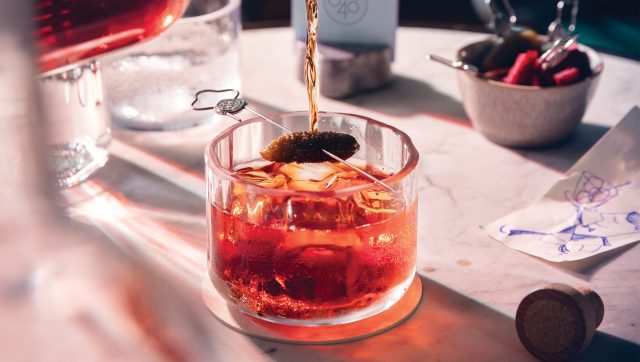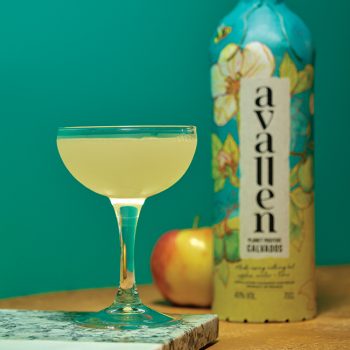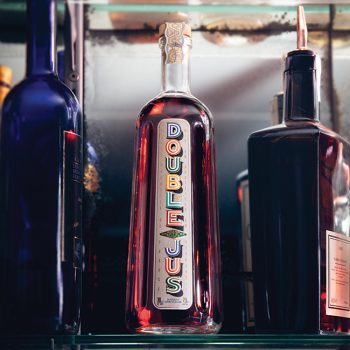Apple watch: what’s new in Calvados?
Calvados producers are experimenting with various finishes, and stressing the liquid’s cocktail credentials to gain market share.

*This feature was originally published in the July 2024 issue of The Spirits Business magazine.
There’s plenty going on in Calvados, with new expressions, big marketing campaigns, and, very possibly, the return of the Appletini – despite the category currently being in decline.
While IWSR Drinks Market Analysis reports a 3% drop in global volume sales between 2022 and 2023, industry body Interprofession des Appellations Cidricoles (IDAC) has been drumming up excitement in the US with a three-year programme, partly funded by the EU. “The reception has been very positive overall – we’re eager to return,” says IDAC head of communications Damien Amadou.
Some producers focused on the US market are Christian Drouin, Domaine du Coquerel, and Maison Busnel. “We’re experiencing robust growth in the US, driven by a rising interest in craft spirits and the rich history of Calvados,” says Victor Vernet, international brand manager at Maison Busnel’s parent company, La Martiniquaise-Bardinet.

Stephanie Jordan, co-founder of Avallen, says: “We remain focused on cracking the North American market. Drinkers on both the East and West Coasts are increasingly seeking out sustainable and innovative spirits, and happen to love apples.”
The UK, where Avallen was launched, remains an important market for the brand. Dawn Davies MW, buying director for The Whisky Exchange and Speciality Drinks, is seeing “growing love for Calvados” here. “There are very few big brands getting Calvados out to a wider audience, but brands like Drouin and Avallen are starting to gain some traction,” she says. “We’re also seeing packaging upgrades from brands like Coquerel, with brands offering simple serve suggestions too.”
While the US has been a main focus, its domestic market, the category’s largest, hasn’t been neglected by IDAC, says Amadou, mentioning an advertising campaign in Normandy coinciding with recent D-Day commemorations.
It’s a challenging market, says IWSR market analyst Arthur Derail. “In France, Calvados is structurally declining and struggling to recruit younger legal-drinking-age consumers, as the drink has an old-fashioned perception for many,” he says, adding that super-premium expressions are faring better than the standard segment. “Consumer education will likely be needed outside of the Calvados region. Some in the industry believe that consumers will resonate with the drink’s origin, and connection with local terroirs.”
Despite these challenges, France remains important to a number of producers. “Although the French market has slowed down over the past year, it’s the market where we have seen the strongest growth over the past 10 years,” says Christian Drouin president Guillaume Drouin.
Busnel too, is doing well at home. “Domestically, we’ve seen steady growth, bolstered by an increasing appreciation for high-quality, artisanal spirits,” says Vernet.
“In France, Sassy Calvados is still growing in the premium on-trade,” reports head of sales Alexander Darley. “We’ve enjoyed being part of the modernisation of Calvados, and putting it in key positions on the cocktail menu.”
The on-trade is an important channel for Calvados. “An increasing number of bars are creating Calvados-based cocktails, which is excellent news,” says Domaine du Coquerel owner Pierre Martin Neuhaus. “We actively promote Coquerel in this channel. It plays a key role in educating consumers about our brand, and the category in general.”
Drouin has created a map of the Parisian bars, hotels and restaurants serving the best Café Calva – a mixture of Calvados and coffee. IDAC, meanwhile, plans to relaunch its cocktail competition for French bartenders, #CalvaClub this year. “The history of Calvados is intrinsically linked to that of French bistros and brasseries,” says Amadou. “Today, cocktails are an essential element of introducing Calvados to consumers, or rather reintroducing – Calvados is mentioned more than 40 times in The Savoy Cocktail Book.”
The on-trade is receptive too, says Davies. “Bartenders have been using Calvados much more in the past few years, and this has only been helped by bars that focus on the category, like London’s Coupette.”
Producers are increasingly working with bartenders. “Last summer we released a wonderful collaboration with [London bar] Tayēr + Elementary: a limited blended Calvados that’s been served on their menus and in their RTD [ready-to-drink] cocktails,” says Vincent Béjot, co-founder of 30&40.
Darley adds: “Using Calvados as more than a digestif has been key. Twists on classic brandy or whisky cocktails, and a few signature serves, have been the focus.”
The return of the Appletini
But for Avallen, it’s all about one cocktail: the Appletini. “It’s a simple, retro cocktail with great margins, cool bar appeal, and a delicious taste,” says Jordan, of the vodka and Calvados-based serve.
Domaine du Coquerel is on board, as is 30&40, and Amadou says that IDAC is getting involved too. “As part of our deployment in the US, we’re trying to focus on a few simple, meaningful recipes that are easy to reproduce,” he says, listing the drink alongside the Jack Rose, Espresso Martini, and Calvados Highball.
“These are very different cocktail profiles that all highlight the versatility and richness of Calvados.”
As a category, Calvados has heritage, a following in various export markets, and producers creating a number of interesting new expressions, but it might just be the Appletini that turns its fortunes around.
What’s new in Calvados
For a category with no shortage of tradition, there’s certainly been a lot of innovation lately, in various forms.
“Calvados is taking the lead from the popularity of different cask finishes from the Scotch industry,” says Dawn Davies MW of The Whisky Exchange and Speciality Drinks. “We’re seeing a lot of innovative collaborations from Drouin, Roger Groult, and Père Magloire, appealing to a broader audience of people that love aged spirits.”
Recently Domaine du Coquerel teamed up with Parisian craft brewery Fauve to create what’s thought to be the first Calvados aged in a beer cask.

Last September, 30&40 introduced Fine Bocage, a blend of two to three-year-old Calvados, and plans to add to its series of single cask releases too. But the company’s focus remains on its best seller, Double Jus, a 23% ABV blend of pommeau, Calvados and rum that recently benefitted from some updated packaging.
New in Calvados-based apéritifs is ABC de Christian Drouin, inspired by French vermouth production, and made with young Calvados, apple juice and botanicals. Drouin is known for its Expérimental range of Calvados, finished in rum or whisky casks, with the latest a collaboration with Scotch distillery Arran.
Maison Busnel, too, produces a range of cask-finished Calvados, but recently applied its 200 years of distilling expertise to other spirits categories instead, creating a range of whiskies, as well as a vodka and a gin.
Avallen, meanwhile, aims to promote the Appletini with the creation of a canned version of the cocktail, together with a UK ready-to-drink cocktail brand, planned for this autumn.
Related news
Mataroa Gin features at Roma Bar Show
